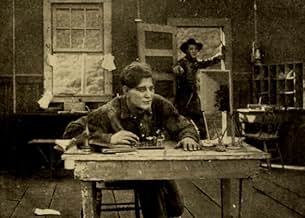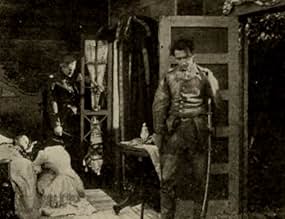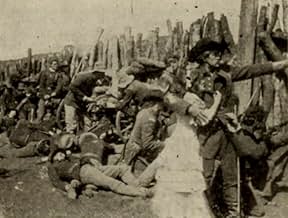Füge eine Handlung in deiner Sprache hinzuThe U.S. Army and the Indians sign a peace treaty. However, a group of surveyors trespass on the Indians' land and violate the treaty. The Army refuses to listen to the Indians' complaints, ... Alles lesenThe U.S. Army and the Indians sign a peace treaty. However, a group of surveyors trespass on the Indians' land and violate the treaty. The Army refuses to listen to the Indians' complaints, and the surveyors are killed by the Indians. A vicious Indian war ensues, culminating in a... Alles lesenThe U.S. Army and the Indians sign a peace treaty. However, a group of surveyors trespass on the Indians' land and violate the treaty. The Army refuses to listen to the Indians' complaints, and the surveyors are killed by the Indians. A vicious Indian war ensues, culminating in an Indian attack on an army fort.
- Regie
- Drehbuch
- Hauptbesetzung
Empfohlene Bewertungen
The main story starts with a Native American tribe that puts its confidence in a treaty with the US government, only to find out very shortly that they have been deceived. The further developments from this setup are intertwined with some romantic sub-plots involving characters from both groups. These romances are used mostly to drive the action, but at times they are also used to illustrate some worthwhile ideas.
"The Invaders" is very good for its time in telling a fairly involved story with good technique, and in using good, detailed settings that work well. Except for the sometimes plain-vanilla characters, it is well above the average quality of movies made in 1912. It is also worth seeing for the action and the interesting story.
In fact, Ince produced and Francis Ford directed and starred, although IMDb says Ince co-directed.
For 1912, "The Invaders" is fascinating and incredibly well done. The acting is occasionally a bit over-wrought, though not for 1912.
In that version at YouTube, there are very few intertitles, which seems strange since the great C. Gardner Sullivan is the writer. Sometimes, because of the paucity of intertitles, a viewer might not know entirely just what is going on.
However, the story, because of the acting and directing, is mostly very clear to viewers.
Again, remember: It's 1912. As the prologue says, viewers in 1912 were not very far removed from the scene and action of actual frontier battles. Custer recklessly led his command to destruction in 1876, not even 40 years before the production and presentation of this movie.
The Battle of Little Bighorn was more closely contemporary to the 1912 audience than, for example, the Battle of the Bulge is to a 2017 audience.
I am very impressed by "The Invaders," for its treatment of the "Indians," for its production values, and for its story-telling virtues.
I hope you will brave the poor quality of the print at YouTube and give a look at "The Invaders."
John Ford, the director with the most Oscars, had an older brother, Francis, who appears as the Colonel in "The Invaders." Francis, who served in the Army during the Spanish-American War, gravitated towards film soon after and worked under Ince out West as a director/actor. He was involved in close to 400 films. Today's viewers may know him as the old man dying on his deathbed in John Ford's "The Quiet Man," only to wake up, get out of bed and run towards the epic fist fight occurring outdoors between John Wayne and Victor McLaglen.
Ford was part of a massive enterprise run by Thomas Ince, a former actor-turned-director who took the reigns of New York Picture Company's western operations, Bison Studios. Once Ince arrived in Los Angeles, he got his employers to agree to lease 18,000 acres between Santa Monica and Malibu where he could realize his dream of reinventing the way movies could be made. He immediately had numerous simple sets built, creating every imaginary backdrop to serve all types of film categories. He hired literally an entire army of wild west show actors with its livestock from Oklahoma as well as an entire Sioux tribe numbering 200.
With such overhead expenses, Ince realized Bison would have to pump out a number of films each month using an entirely new production system than what the movie industry had been operating since its inception. No more would the director have deliberate sole control of constructing an entire film. Ince placed a producer in charge to oversee one entire movie, from its beginning to completion. Unique was how a movie originated. A detailed script would be submitted by company writers for approval by the studio executives (mostly Ince). The script, a first in cinema, would describe each movement of its actors, what the title cards would state, and the types of sets required. The producer, with the director's advice, would cast the actors and oversee the process throughout its production. Finally, an editor specializing in slicing a film together would take over the duties that a director would normally do. Hence, this assembly-line method of constructing a movie would allow Ince's studio to release as many as three films a week, over 150 in 1913 alone.
This system would be adopted by major movie studios in the future, assuring an insatiable movie-going public a constant stream of new films for their local theaters.
Wusstest du schon
- WissenswertesOne of the films in the three-disk boxed DVD set called "More Treasures from American Film Archives (2004)," compiled by the National Film Preservation Foundation from five American film archives. This film is preserved by the Library of Congress (from the AFI/Blackhawk collection), has a running time of 41 minutes and an added piano score.
- Zitate
Title Card: SKY STAR OVERHEARS THE PLAN TO MASSACRE THE WHITES.
- VerbindungenReferenced in Adam Piron: What Is an Indian? (2025)
Top-Auswahl
Details
- Laufzeit41 Minuten
- Farbe
- Sound-Mix
- Seitenverhältnis
- 1.33 : 1
Zu dieser Seite beitragen






















